


Originally written and posted on my Web Site on August 5th, 1998;
this opinion paper was EDITED, UPDATED, and re-posted in June, 2002
BETTER YET!:
See MY NEW (2005) Opinion Paper related to this article!:
"A Comprehensive Review of Frequently Misinterpreted
and Misrepresented Restraint Research"
However ... if you are truly interested in reading the OLD version of my review ... HERE IT IS:

Re: Chan TC, Vilke GM, Neuman T, Clausen JL: Restraint position and positional asphyxia.
Ann Emerg Med November 1997;30:578-586.
The November, 1997 "clinical investigation" report by Chan et al., purported to be related to the effects of "hobble" or "hogtie" restraint position, has at least FOUR serious flaws.

FLAW #1: "Study Objective: To determine whether the 'hobble' or 'hogtie' restraint position results in clinically relevant respiratory dysfunction."
In the body of their article, the authors correctly described the hobble or hogtie position as when, "individuals are placed in the prone position with their wrists handcuffed or tied together behind their backs and their ankles bound together and secured to their wrists."
However, the authors describe their study's restraint position as, "each wrist and hand were taped to an armboard, which was then taped to the sole of the ipsilateral ["same side"] shoe with the knee flexed behind the subject. The metacarpal-phalangeal joints of the hands were placed in line with the heels of the feet. ... The subject's feet were then taped together and his head was turned to the side."
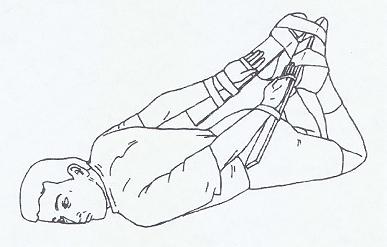 |
commissioned and published by the authors, demonstrating the "RESTRAINT POSITION" employed for their study.
"hobble" or "hogtie" restraint! |
The authors suggest that the restraint position they employed for their study (Figure 1 - above) "closely approximates" hobble restraint. I strongly disagree. This position clearly allows the healthy study subjects' shoulders to rest and relax upon the floor, additionally allowing their knees to reach the floor. Thus, if the healthy study subjects experienced any difficulty breathing, they easily could have compressed their shoulders and knees to the ground, affording their chest and ABDOMEN better room to expand - thus allowing them to breathe easier! It is unlikely that the study's authors would have noticed this minor - but significant - amount of movement. TRUE hobble restraint would NOT have allowed the study subjects such an opportunity to ease their ability to breathe.
Here are four photos of REAL Hobble Restraint:
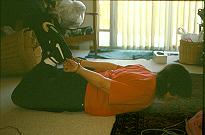 |
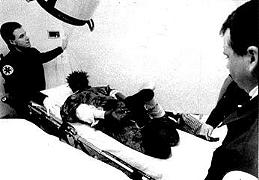 |
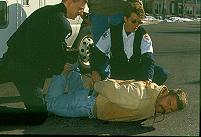 |
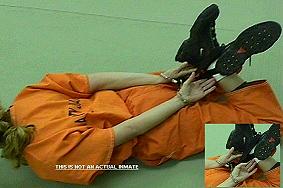 |
of ALL these individuals are pulled UP and OFF of the ground ... Note that their KNEES are also somewhat pulled UP and OFF of the ground ... |
To "justify" their study's avoidance of a true hobble restraint position, the authors cited the need "to allow secure placement of a radial artery line." I am a paramedic - not a research scientist (Jim!). But, I strongly suspect that another artery could safely have been cannulated (such as the easily-accessible BRACHIAL artery), in order to facilitate an accurate, and applicable, study of individuals placed in a TRUE hobble restraint position. Because the study's authors neglected to do so, the study findings are NOT RELATED to their purported "Study Objective."
 |
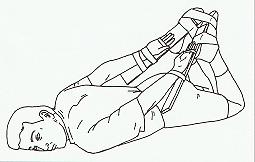 |

FLAW #2: The study's 15 subjects were men between the ages of 18 and 40. None of them had ANY history of respiratory or cardiac disease. None had a seizure disorder, none had diabetes. None of them had ANY illness, of any kind. They each had a low "body mass index" (a politically correct way of saying that they also were not "fat"). They were urine-tested to be sure that they were not "recreational drug" users.
These 15 healthy male specimens performed only 4 minutes of minimally-exertive, and controlled, exercise - they bicycled on a machine - prior to submitting to "the restraint position" used by Chan et al.
Indeed, at the very end of their report, Chan et al. state that their study found, "no evidence to suggest that hypoventilatory respiratory failure or asphyxiation occurs as a direct result of body restraint position in healthy, awake, nonintoxicated individuals with normal cardiopulmonary function at baseline."
Thus, unless a Restraint Asphyxia victim was an entirely "healthy" person; and had only experienced 4 minutes of minimally-exertive, controlled, exercise prior to being restrained in a comfy prone position; this study's findings CANNOT be cited as having ANY relationship to their death.
To date, I have never heard of, nor reviewed case materials about, a Restraint Asphyxia victim who fits the above description. Individuals requiring full-body restraint are consistently documented as having an altered level of consciousness (from some kind of "unhealthy" cause). Also, they are consistently documented as experiencing a much more significant amount of exertion than 4 minutes on a bike, prior to experiencing a Restraint Asphyxia death. (Exertion such as a 15- to 60-minute period of running amuck ... OR, a full-body seizure ... OR, are still experiencing a hypoglycemic episode.)

FLAW #3: Within the title and body of their report and its "Conclusions," the authors accurately avoided calling their study position "hobble" or "hogtie" restraint. Instead, they referred to it as a "restraint position." However, by including the terms "'hobble' or 'hogtie' restraint position" in their "Study Objective," the authors erroneously INFERRED a relationship between their study's conclusions and the "'hobble' or 'hogtie' restraint position."
"Study Objective: To determine whether the 'hobble' or 'hogtie' restraint position results in clinically relevant respiratory dysfunction."
"Conclusion: In our study population of healthy subjects, the restraint position resulted in a restrictive pulmonary function pattern but did not result in clinically relevant changes in oxygenation or ventilation."
The above two statements were published on the same page of the article; the FIRST PAGE. They are separated by two lengthy paragraphs containing pedantic summaries of the study's "Methods," and technically-noted scientific values of the study's "Results."
Most readers (especially "lay" persons who read the article - such as attorneys, judges, or law enforcement officers!) do not read the lengthy "Methods" and scientific "Results" paragraphs, the ONLY paragraphs from the first page of this study that receive attention are the objective and conclusion paragraphs.
Because of the terminology used in these closely-associated paragraphs, the authors INFER that "the 'hobble' or 'hogtie' restraint position" does NOT cause "clinically relevant changes in oxygenation or ventilation." This is an entirely UNTRUE conclusion, and is entirely unsupported by this study. NO WHERE in their study's report do Chan et al. state that their study results showed "hobble restraint" as resulting in clinically irrelevant oxygenation or ventilation changes.
Obviously, Chan et al. cannot be held "responsible" for others' misinterpretation of their study's findings. However, I strongly believe that they purposefully misled readers by using erroneous terminology in their objective, and by neglecting to identify the absence of relevance between their study's findings and actual field application of HOBBLE RESTRAINT within their conclusion.
Additionally, when they did admit the lack of relationship between their study and field conditions, they did so in a vague and misleading manner.
Within their report, Chan et al. admit, "It is unlikely that [our study's] period of exercise would simulate all the physiologic alterations that may occur with struggle and agitation ..." and, "It is possible that a combination of factors, including underlying medical condition, intoxication, agitation, delirium, and struggle as well as body position, may result in respiratory compromise that would not be detected by our study."
It is "possible" that their study wouldn't detect respiratory compromise caused by conditions and factors that were entirely absent from their study? It is more than "possible!" It is a FACT that their study could not detect conditions and factors that were not present.
But, why do Chan et al. avoid clearly stating the facts: "Our study was not designed to detect the consequences of, nor collect data related to, actual field application of hobble or hogtie restraint." ...??? Perhaps FLAW #4 might shed a little light upon this question.

FLAW #4: Again, I am a paramedic - not a research scientist (Jim!). But, when persons develop and implement a "scientific research" project specifically at the request of an attorney seeking to defend his clients from responsibility for causing "wrongful death"(2) ... well, I think that strongly indicates a very non-scientific "bias," and a previously-established "agenda!" Studies that are developed and implemented with previously-determined "results" in mind are inevitably SKEWED - and their results cannot be trusted.
Consider these highlights from a San Diego Union Tribune article(3):
14-Jan-1998 WednesdayIt's been listed as the cause of death by medical examiners and been the
subject of wrongful-death lawsuits around the country.But hogtying a suspect, experts now say, can't kill.
A San Diego federal judge has dismissed a wrongful-death lawsuit filed by
the survivors of a Poway man who died after being hogtied by sheriff's
deputies in 1994.The decision last week was based largely on new evidence
developed at the request of a
lawyer for San Diego County....
In preparing for the trial, Sanchez asked Dr. Thomas Neuman, professor of
medicine at the UCSD Medical Center, to conduct a study of positional
asphyxia and the hogtie restraint.
To read the full text of the above newspaper article, CLICK HERE ... and then come right back!
I've been interviewed by newspaper journalists. I know that newspaper journalists often write articles that INFER entirely FALSE things. I know that newspaper journalists often publish out-and-out LIES! (Publish "quotes" that were never said by the individual quoted.)
However, it is a FACT that the "new evidence" this article specifically referred to was Chan et al.'s 1997 study. It is also a FACT that Chan et al.'s 1997 study was presented to the court (by at least one of the authors, Neuman) in a manner that suggested the study having found the use of "hobble restraint" to be without danger!
To date, Chan et al. have never, EVER, published a statement clarifying the fact that their study did NOT conclude that "hogtying a suspect, experts now say, can't kill."
ADDITIONALLY, the Union Tribune article further stated that:
During a recent nonjury trial, a medical expert who first suggested nearly
a decade ago that hogtying suspects can lead to death retracted his beliefs
on the stand after being confronted with the findings of a new study.Dr. Donald T. Reay, the chief medical examiner for King County, Wash., had
maintained for years that blood oxygen levels decrease after someone has
been exercising (as in a violent struggle with deputies). He had maintained
that the hogtie restraint prevents such oxygen levels from rising again
because the restraint impairs the mechanical process of inhaling and
exhaling.
The lies and misinterpretations published by the Union Tribune article were quickly snapped-up and disseminated by law enforcement publications. Here is a snippet of Dr. Reay's response to these ERRONEOUS conclusions and their dissemination:
I readily acknowledged the value of these studies in the San Diego case of "Price vs. San Diego" which had many other features besides hog-tying in the restraint maneuvers used to control the victim. This has since been presented in law enforcement publications as my retraction of positional asphyxia as a cause of death, with particular reference to hog-tying.To read the full text of the Dr. Reay's response, CLICK HERE ... and then come right back!Such is not the case! I still maintain that there are risks and hazards to restraint maneuvers including hog-tying and each case must be evaluated to assess the presence or absence of respiratory restriction in the light of the method of restraint.
Dr. Reay also published his concerns about Chan et al.'s 1997 report, and the misinterpretations it generates, in a letter to the editor of Annals of Emergency Medicine .(4) (That letter is in my Restraint Asphyxia Library!)
Again, Chan et al. have NEVER acted to protect the public from the widespread misinterpretation of their study, by publishing corrections of the misinterpretations it has generated. IN FACT! At least one of the authors (Chan) actually continues to PROMOTE the misinterpretations!
Included in the case materials of a Restraint Asphyxia death for which I have recently been retained as an expert consultant/witness, was a legal affidavit written by Theodore Craig Chan, MD, FACEP, and signed before a Notary Public on the 27th day of April, 2001. This affidavit represents Chan's "sworn testimony" in response to a request that he review some case materials regarding the death in this case. In his affidavit, Chan states that:
"I was directly involved in the research study performed at UCSD, funded by a grant from the County of San Diego for the specific purpose of examining the issue of positional restraint as it relates to pulmonary function and specifically the effect of hobble restraint on respiratory function."(5)
I strongly suspect that the "grant from the County of San Diego" Chan refers to was actually a PAYCHECK received from San Diego County Deputy Counsel, Ricky R. Sanchez. Whether this is true or not, when he wrote the above statement, Theodore Craig Chan, MD, FACEP knew that this study did NOT examine hobble restraint - it examined "a restraint position." Thus, it is entirely clear from his statement, that Chan actually PROMOTES the false correlation between his study's findings and "the effect of hobble restraint on respiratory function" in the field.

IN SUMMARY: Chan et al.'s 1997 study is demonstrably flawed, and clearly does NOT support the idea that use of hobble restraint or forceful-prone-restraint by police and emergency medical personnel is "safe."
Chan et al.'s 1997 study has contributed to serious misinterpretations of the study's findings - misinterpretations that Chan et al. do not seek to rectify (indeed, they even seem to encourage them) - misinterpretations that continue contributing to
additional Restraint Asphyxia deaths!
Based upon the impressive body of research by Forensic Pathologists (Reay et al), and upon my years of research and personal experience with Restraint Asphyxia cases, forceful-prone-restraint, and prone hobble restraint, clearly contribute to Restraint Asphyxia deaths.
AND, THESE PRACTICES MUST STOP!
Ms. Charly D. Miller, Paramedic
EMS Author, Educator, Consultant

REFERENCES:
(1) Chan TC, Vilke GM, Neuman T, Clausen JL: Restraint position and positional asphyxia. Ann Emerg Med November 1997;30:578-586.
(2) United States District Court, S.D. California. Ann Price et al., Plaintiffs, v. County of San Diego et al., Defendants. Civil No. 94-1917-R (AJB).
(3) J. Harry Jones: "Police hogtie restraint doesn't kill, evidence now shows - Case here may have impact nationwide." The San Diego Union-Tribune; 14-Jan-1998.
(4) CORRESPONDANCE section: Positional asphyxia letter from Howard JD and Reay DT. Ann Emerg Med July 1998; 32:116-117.
(5) This affidavit is not "published" anywhere, and is part of an on-going case. Thus, I cannot "cite" it as a "reference." Upon conclusion of the case, it is likely that I will post the affidavit in my Restraint Asphyxia Library.


 Email Charly at: c-d-miller@neb.rr.com
Email Charly at: c-d-miller@neb.rr.com